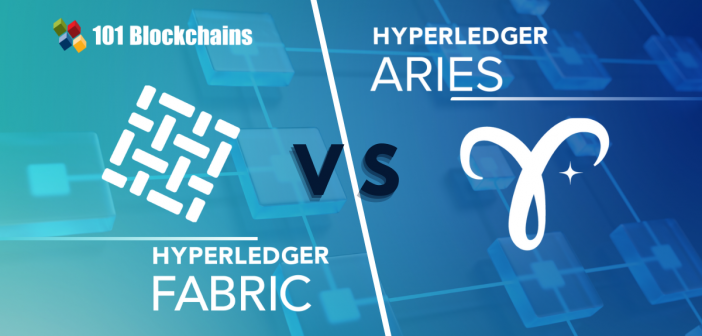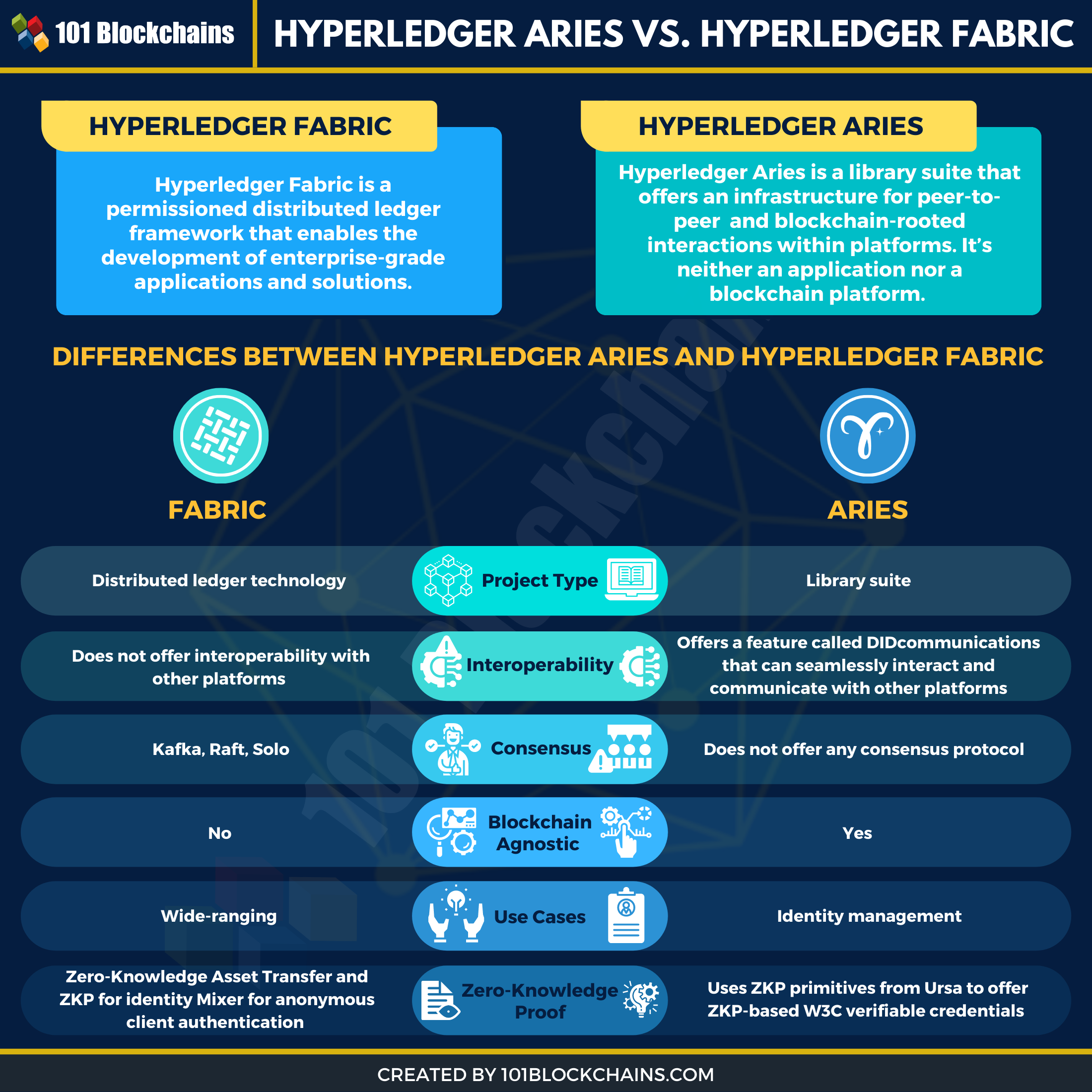Learn how blockchain truly works, master key definitions, and uncover what makes smart contracts so "smart." Dive into the fundamentals, gain valuable insights, and start your blockchain journey today!

- Reviews
Hasib Anwar
- on April 15, 2021
Key Differences Between Hyperledger Aries and Hyperledger Fabric
This article will shed light on Hyperledger Aries vs Fabric to understand their fundamentals differences and possible use case scenarios.
Hyperledger blockchain is one of the prominent players in the blockchain markets, with 16 projects under its wing. Among them, Hyperledger Fabric is one of the widely used blockchain platforms in various enterprise implementations. Hyperledger Aries, on the other hand, was an ongoing project that becomes active recently. According to Hyperledger, Aries is closely connected to their other 2 projects – Hyperledger Indy and Ursa.
Here, we will discuss how Hyperledger Aries and Fabric are different from each other and will also understand their use cases and key characteristics.
Want to learn the basic and advanced concepts of Blockchain and Hyperledger Fabric? Enroll Now: Getting Started with Hyperledger Fabric Course
What is Hyperledger Fabric?
Before we compare both Hyperledger projects, we’ll briefly introduce the two projects and their characteristics. Let’s start with Hyperledger Fabric. Hyperledger Fabric is one of the prominent open-source distributed ledger technology projects under Hyperledger. It’s an enterprise-grade blockchain platform that offers protocols, ledgers, smart contracts, standards and many more key blockchain elements.
Anyhow, Hyperledger Fabric is a permissioned blockchain, and it does not support any permissionless iterations. Therefore, it offers an authentication method to authenticate users before they can get access to the network. This is one of the safest and secure blockchain platform suited for enterprise companies.
Hyperledger Fabric 2.0 is the latest version of this platform, and it does offer certain extra functionalities like chaincode lifecycle management, external chaincode launcher, improved performance and so on.
Basic Characteristics of Hyperledger Fabric
There are some certain basic characteristics of the Hyperledger Fabric project. Let’s understand what functionalities they offer.
-
Open-Source Code
This platform is fully open-source. Therefore, anyone can get access to the source codes and use them in any way they want. You won’t have to buy the platform from them or pay any fees to buy a license. More so, they don’t have any issues regarding vendor lock-ins.
-
Wide-Ranging Industrial Usage
If you check out any Hyperledger Fabric tutorial, you will notice that the internal architecture and features go hand in hand with many industries. More so, there are already many companies using Fabric for their blockchain solution, and these solutions are performing extremely well.
-
High-Quality Infrastructure
All of the source code and the infrastructure is carefully designed to make it perfect. In reality, the developers behind Fabric make sure to quality check every single programming before they finalize it. So, you can always expect the best output from them.
-
Higher Efficiency
Hyperledger Fabric offers a highly efficient output compared to other enterprise blockchain platforms at the moment. As it can separate transactions from other functions within the network and streamline the verification process much faster.
-
Modular Design
Hyperledger Fabric offers a modular structure. Therefore, you can design any independent module and just add it to the network. In reality, this feature adds customizability to the whole platform. Anyhow, let’s check out Aries in this Hyperledger Aries vs Fabric guide right now.
Build your identity as a certified blockchain expert with 101 Blockchains’ Blockchain Certifications designed to provide enhanced career prospects.
What is Hyperledger Aries?
Hyperledger Aries recently became active, and it’s now ready to use according to the Hyperledger community. It’s actually a library suite that offers an infrastructure for peer-to-peer network and blockchain-rooted interactions within platforms. However, it’s neither an application nor a blockchain platform. More so, Hyperledger Aries uses the cryptographic support from Ursa to offer better key management and secret management systems.
What Purpose Does Hyperledger Aries Serve?
Aries comes from both Hyperledger Indy and Ursa. More so, from Ursa, Aries gets the cryptographic functionality, and from Indy, it gets an implementation of the resolver. Therefore, the main purpose of Aries is to alter the client layer within the Hyperledger Indy infrastructure to make it suitable for interacting with other platforms. Aries actually implements a standard for interoperability in this case. Anyhow, let’s check out the key characteristics of Aries in this Hyperledger Aries vs Fabric guide.
Key Characteristics of Aries
- Blockchain interface layer or resolver for reading, creating and signing transactions.
- Cryptographic storage for verifiable credentials, cryptographic secrets, and other information for clients.
- Peer-to-peer encrypted messaging unit to support off-ledger interactions within platforms.
- ZKP-based W3C verifiable credentials mainly come from Ursa.
- Higher-level protocol series that ensures deployment and independent implementation of Aries agents.
- Production ready framework for Aries deployments and Hyperledger use cases. Every framework is suited for a specific use case.
- Test harness for agents to ensure proper interoperability testing before launching.
Hyperledger Aries vs Fabric: How Are They Different?
The comparison of Hyperledger Aries vs Fabric is rather a difficult approach as both projects are quite different from each other. We’ve compiled some of the crucial differences you need to know before you start using these projects for your blockchain development.
-
Project Type
The very first difference between Hyperledger Aries and Fabric is the types of Hyperledger project type. Fabric is actually a distributed ledger technology, a fully functioning blockchain platform with nodes, transaction protocols, consensus, smart contracts, etc. Therefore, companies can use this platform to develop other projects.
On the other hand, Aries is a library suite or toolkit that offers an array of protocols and modules for blockchain platforms. Thus, Hyperledger Aries is not a blockchain platform in any way. You can use Aries to integrate certain functionalities in your blockchain projects, but you can’t use Aries as your blockchain project base.
-
Blockchain Agnostic
Blockchain agnostic actually means that a company can operate a solution from multiple blockchain platforms. At present, most of the applications only use a single blockchain platform that offers specific use cases and functions. Therefore, there is no blockchain application that can communicate with other blockchain platforms seamlessly.
In this case, Hyperledger Fabric does not offer any solutions. This means that Fabric is not blockchain agnostic. The Fabric still does not offer any protocols regarding this issue in their latest version. On the other hand, Aries is fully blockchain agnostic. It means that any kind of blockchain platform can use this tool to connect to other blockchain platforms.
-
Interoperability
Interoperability is one of the major issues of any blockchain platform. Blockchain platforms can’t still offer interoperability with other solutions and this makes it very limiting. At present, Hyperledger Fabric does not offer any blockchain interoperability protocols that can communicate with other networks.
On the other hand, Hyperledger Aries offers a feature called DIDcommunications that can seamlessly interact and communicate or even offer messing services with other blockchain platforms. Anyhow, let’s look at the next difference in this Hyperledger Aries vs Fabric guide.
-
Zero-Knowledge Proof
Hyperledger Aries and Fabric both have ZKP protocols attached to them. But the usage of Zero Knowledge Proof is different in both projects. In Fabric, you can use ZKP for identity Mixer for the anonymous client authentication process. You can also use Zero-Knowledge Asset Transfer for preserving privacy in case of assets exchange.
On the other hand, In Hyperledger Aries, you will get ZKP-based W3C verifiable credentials. It uses the ZKP primitive from Hyperledger Ursa at the moment. So, both projects use ZKP, but they are use it for different functionalities.
-
Consensus
As Hyperledger Fabric is a blockchain platform, it comes with various consensus algorithms that you can use for your blockchain implementations. At present, Fabric will offer Solo, Kafka and Raft consensus methods to verify transactions. On the other hand, Aries is not a blockchain platform but a library suite. However, in the library suite, you will not get any new consensus protocol suited for blockchain platforms. We don’t know if Hyperledger is planning to include any protocols in the future that may offer consensus methods as of now.
-
Use Cases
Hyperledger Fabric is a fully functioning platform; thus, it’s developed to be used in various industries. Many companies using blockchain technology are already using Fabric for various use cases. Furthermore, you can use this platform for supply chain, trade finance, real estate, insurance and so on.
But Aries is developed focusing on digital identity. Therefore, it’s more suited for any identity management solutions. As of now, it supports Hyperledger Indy, so you can couple Indy and Aries to develop an interoperable identity management system.
Here’s a guide to Hyperledger Fabric use cases and case studies that you can check out to learn more about the platform.
Hyperledger Aries vs Fabric: Comparison Table
| Hyperledger Fabric | Hyperledger Aries | |
|---|---|---|
| Project Type | Distributed ledger technology | Library suite |
| Blockchain Agnostic | No | Yes |
| Interoperability | Does not offer interoperability with other platforms | Offers a feature called DIDcommunications that can seamlessly interact and communicate with other platforms |
| Zero-Knowledge Proof | Zero-Knowledge Asset Transfer and ZKP for identity Mixer for anonymous client authentication | Uses ZKP primitives from Ursa to offer ZKP-based W3C verifiable credentials |
| Use Cases | Wide-ranging | Identity management |
| Consensus | Kafka, Raft, Solo | Does not offer any consensus protocol |
Conclusion
Hyperledger Aries and Fabric are both wonderful and functioning projects from the Hyperledger consortium. However, they are both different in every possible way. Hyperledger Fabric is a fully functioning distributed ledger technology, and Aries is a newly active library suite that targets specific needs for digital identities. Over the years, Fabric is getting a fair share of traction and established its position as a viable solution for enterprises companies.
Judging by the revolutionary addition of interoperability protocol in Aries, we can only assume that Hyperledger Aries will soon take the spotlight. If you are curious about learning more about Hyperledger Fabric, then we suggest you start with our getting started with Hyperledger Fabric course right now!
*Disclaimer: The article should not be taken as, and is not intended to provide any investment advice. Claims made in this article do not constitute investment advice and should not be taken as such. 101 Blockchains shall not be responsible for any loss sustained by any person who relies on this article. Do your own research!






